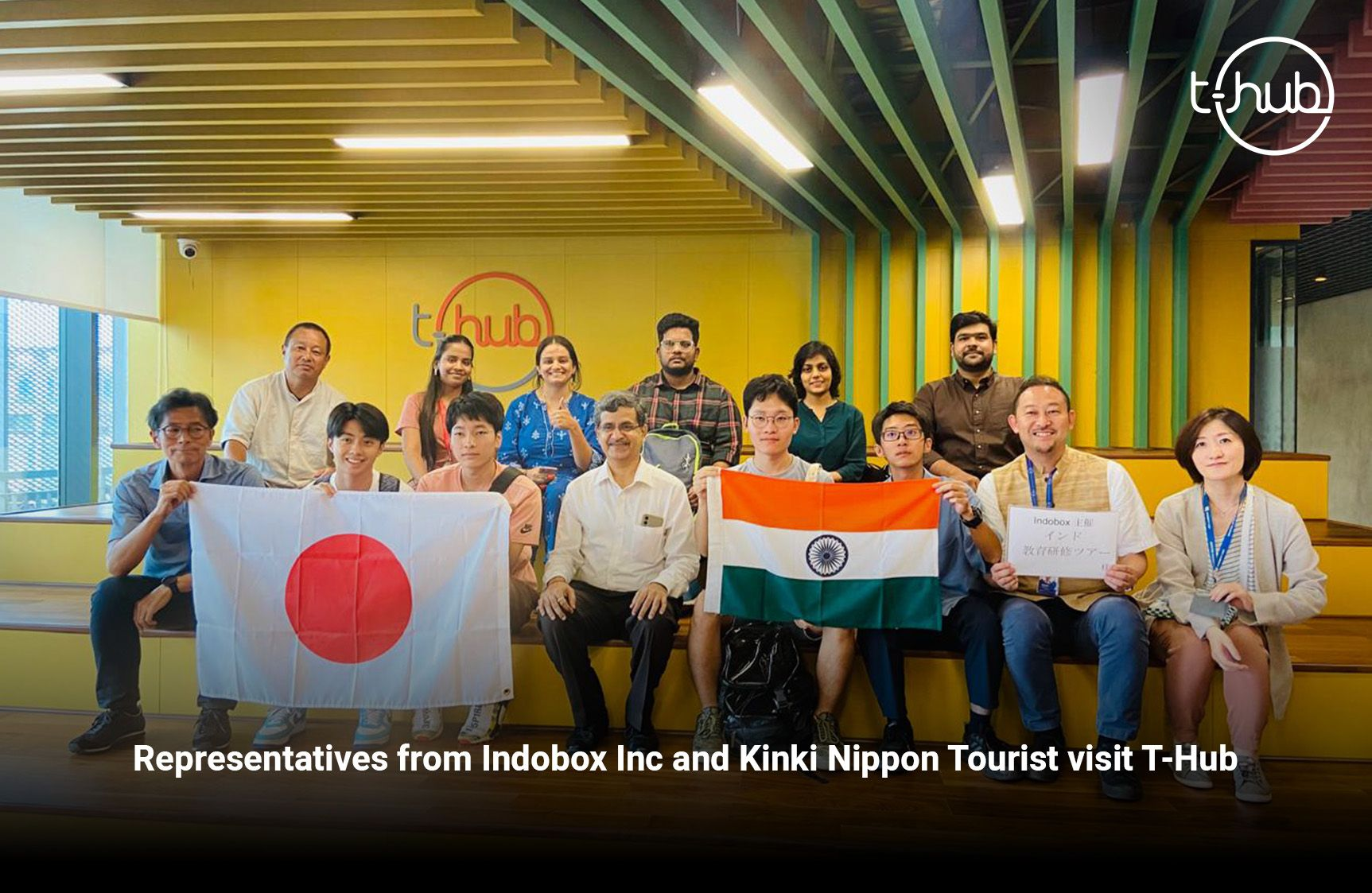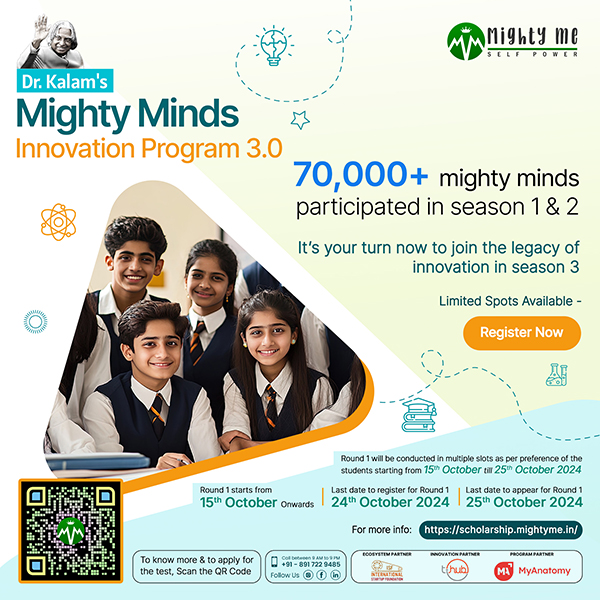The world-over, women are breaking barriers and shattering the glass ceiling across industries and professions. They are busy creating a new world order that allows them to challenge age-old norms and bridge gender disparity in the workplace.
India’s burgeoning innovation ecosystem boasts of some of the most accomplished and enterprising women who are breaking stereotypes and boldly carving a niche for themselves in a highly competitive male-dominated landscape.
This Women’s Day, T-Hub is proud to present its brigade of powerful women professionals who work hard to fuel innovation and entrepreneurship in Telangana and beyond—thereby, inspiring other women to follow suit.
At T-Hub, the focus has always been on promoting diversity and inclusivity and empowering women leaders to drive entrepreneurship and innovation to new heights.
What are the different ways in which T-Hub’s “women warriors” are contributing to the startup and corporate innovation ecosystem? What motivates them to pave their own path, despite the myriad challenges on ground? What have been some of their key learnings from being an integral part of T-Hub’s success story?
Let us find out from them:
Arthi Balu
Q. What is the secret sauce to managing a vibrant community teeming with aspiring women entrepreneurs?
Great communities are often built by good and empathetic listeners. Most of the times the best thing one can do to an entrepreneur is to be there and listen to their side of the story. When it comes to women running businesses, I strongly believe that women are born entrepreneurs. The way a women manages various roles as part of her personal life is a lot of work when compared to that of a successful CEO. It’s just that we women often do not actively seek credit for the work we put in our personal life.

Also in terms of stakeholder management and community building, women are naturally empathetic towards various situations and have a high level of emotional intelligence in maintaining healthy relationships. These two attributes are the foundation of any thriving startup community. But unfortunately, the percentage of women in leadership roles—especially in the startup ecosystem—still needs to improve. We need to seriously work towards bringing this percentage up, if we want to build sustainable and thriving startup communities around the world.
Geeta Buddana
Q. What, according to you, are some of the most pressing problems women entrepreneurs face in India? Can you share unique insights from T-Hub’s hiring strategy that empowers women aspirants in the innovation ecosystem?
Innovation ecosystems are of central importance to building India’s innovation economy. In the world of innovation, far fewer women innovators own patents as compared to men. I also believe there is an urgent need to tackle gender bias.

Innovation is not just about creating new technologies; it is also about creating new ways to collaborate, work and do business. At T-Hub, women are given equal opportunity and flexibility in terms of allowing them to grow and participate at all levels. The participation of women in decision-making is increasing at T-Hub, which gives much scope for all of us to grow and develop.
Mansi Sheth
Q. What is the critical role mentoring female entrepreneurs plays in empowering them to succeed in the innovation ecosystem? Can you narrate a real-life example where mentoring has had a positive impact on a woman entrepreneur?
In every ecosystem, each one of us has a unique role to play, so it is with the innovation ecosystem as well. As entrepreneurs, be it male or female, the goal is to build a successful business and drive it to scale. How it is achieved forms the core essence of the startup that defines their business.

When it comes to female entrepreneurs, they bring in a perspective that is coupled with empathy, understanding, and the ability to multitask, which comes naturally to them, and is a huge asset that contributes to the growth of a business. This is where mentoring plays a critical role in helping them understand their strengths and empowering them to create success stories. I think that differentiating one as a male or female entrepreneur is flawed. An entrepreneur’s success is defined by his/her core and how they weave the same into their business. I am citing an example of a male entrepreneur (as I believe that the founder’s gender and the startup’s success are unrelated) who we all admire: Mr. Steve Jobs. It was his passion for design and his ability to make others believe in his vision that made Apple successful, and not because he is a man.
Mugdha Jhanjhote
Q. What has been your role in engaging with a vibrant startup community at T-Hub? What aspect of your role do you enjoy the most?
As a part of the Business Management team, founders are like customers for me and I engage with them to better understand their pain points when it comes to products that I build for them. Also, co-creating solutions with them over the last one year has been an enlightening experience.
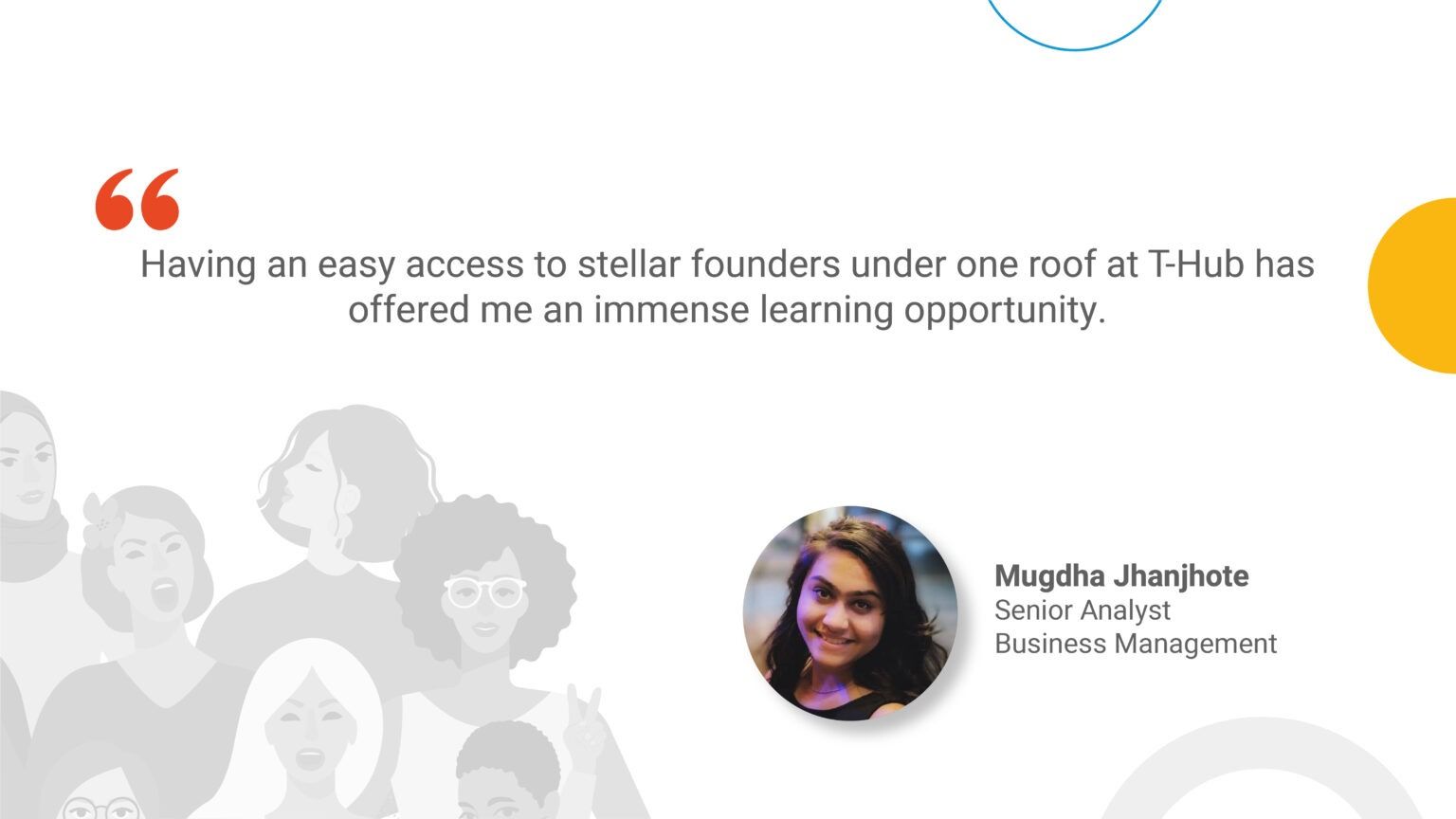
When I joined T-Hub, I wanted to make a positive impact on the lifecycle of products startups are building. And hence, assisting startups in product development was one of the initiatives I took up at T-Hub and it has been a truly insightful experience for me.
Having an easy access to stellar founders under one roof at T-Hub has offered me an immense learning opportunity. I love talking to founders as they are a perfect sounding board for bouncing off ideas!
Nidhi Mehta
Q. How do you navigate a senior marketing role at T-Hub to shape the future of innovation across India’s innovation ecosystem?
I believe being able to adapt to customer behaviour and new technologies while maintaining a strong customer focus is essential to great marketing in India’s innovation ecosystem. As an experienced marketer, I focus on creating an incredible customer experience for our stakeholders. This means delivering value beyond their needs. Ultimately, innovation is crucial for great marketing because there will always be room to improve brand relationships and improve the customer experience journey. Today’s advanced innovations such as additive manufacturing, bitcon and virtual reality have gotten a lot of traction, but they and other revolutionary products and solutions need the right marketing expertise to generate the depth and breadth of market engagement they seek.
Innovation alone may be enough to initiate the adoption life cycle, but marketing remains the bridge necessary to cross the chasm between early adopters and the wider group of people who will form a viable, valuable customer base.
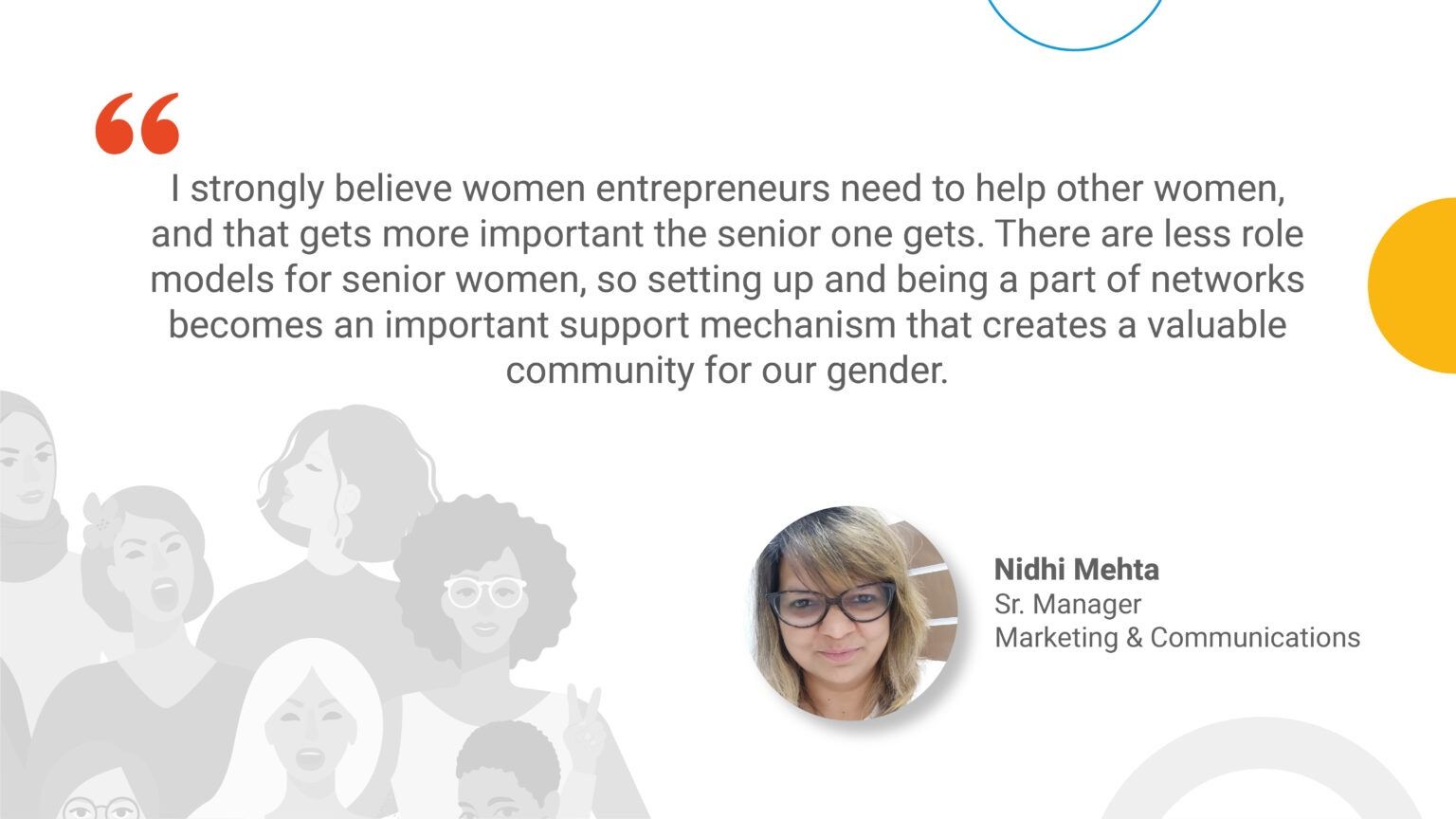
Therefore, the bigger the innovation, the bigger the risk of failure. Since marketing has the capability to reduce those risks, it matters as much—or more than innovation.
Q. What aspect of your role do you enjoy the most?
There are no silver bullets in a senior marketing role in the innovation ecosystem. You need to be passionate and empathic about what you contribute to fuel innovation and work hard to take advantage of the opportunities that cross your path.
Reflecting on my own journey of close to two decades, I acknowledge three factors that have been critical to my success-
1. Building and maintaining meaningful relationships and networks
2. Being a student for life
3. Saying ‘Yes’ when others show confidence and trust in you
Q. How crucial is it for women entrepreneurs to play an integral part in enabling innovation and creating role models for their gender?
I strongly believe women entrepreneurs need to help other women, and that gets more important the senior one gets. There are less role models for senior women, so setting up and being a part of networks becomes an important support mechanism that creates a valuable community for our gender. For women entrepreneurs, digital technology has acted as a game-changer. They are communicating and collecting information and making decisions at a business level, which could be beneficial for our society and aid in developing the economic status of our country.
Priyanka Ravala
Q. In your experience of leading international programs at T-Hub, how different are women entrepreneurs from other geographies compared to women entrepreneurs in India—or are they cut from the same cloth?
I interact with two different kinds of women at the international level: one set who are CEOs/co-founders who are bringing in new technologies/platforms/solutions and the other are the ones who are leading the accelerators and helping various startups. Both sets of women are visionaries, greatly confident, ambitious, goal-oriented and tech savvy. I was curious to know what made them choose something different from other, ‘regular’ jobs. Their answer was the self-confidence and early support that they had imbibed in their schooling, along with a curriculum that encouraged strategy management and entrepreneurship as a potential career path.
Even though there are a decent number of Indian women who are in entrepreneurship and building new technologies, there are very less numbers from our gender who are driving the accelerators or helping startups become visible in the ecosystem.
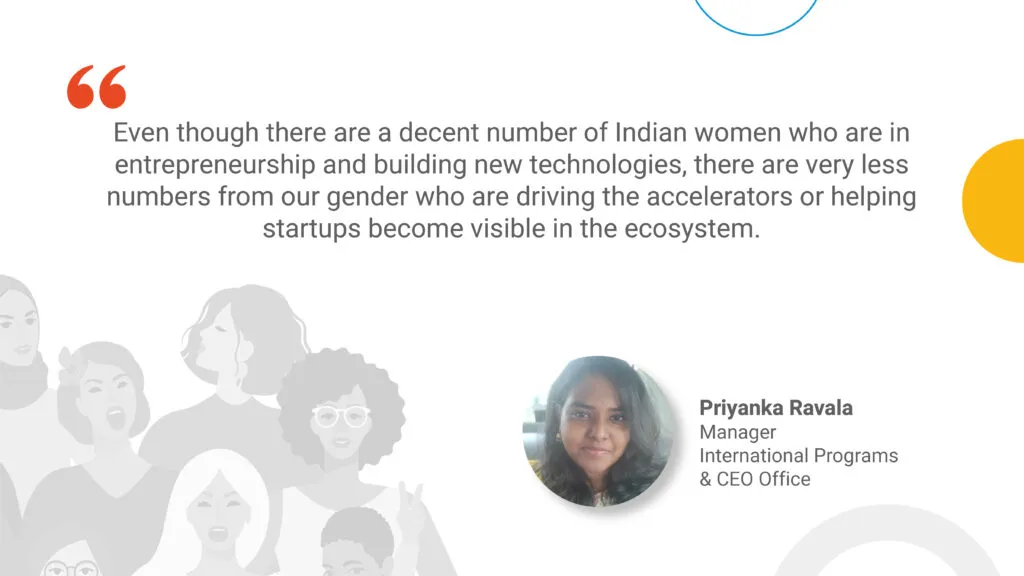
Q. What can women entrepreneurs from international regions learn from their female counterparts in India, and vice-versa?
Most of the international entrepreneurs I have interacted with had set up their offices at home, even before the pandemic. Working from home helped them manage home and work responsibilities. These women are very vocal about the ideas/solutions that they want to bring into the ecosystem. They also voice their needs in a very subtle and effective way with Proof of Concepts. Compared to Indian entrepreneurs, they are more open to taking risks and are passionate about engaging with new technologies and new trends in the ecosystem. They have clarity of outlook on every aspect of the product they launch and work in a more flexible and open work environment.
Priyanka Sharma
What has been your role in shaping startup innovation at T-Hub?
As a program manager, I believe it’s very crucial for me to ensure qualitative deliverables to startups throughout the course of the program and beyond. Providing startups with the best of services by helping them get the right connections and advisory support as and when they require it is of utmost importance to me—and I take that rather seriously. I make sure to maintain healthy relations with all the stakeholders who have been directly or indirectly associated with us.
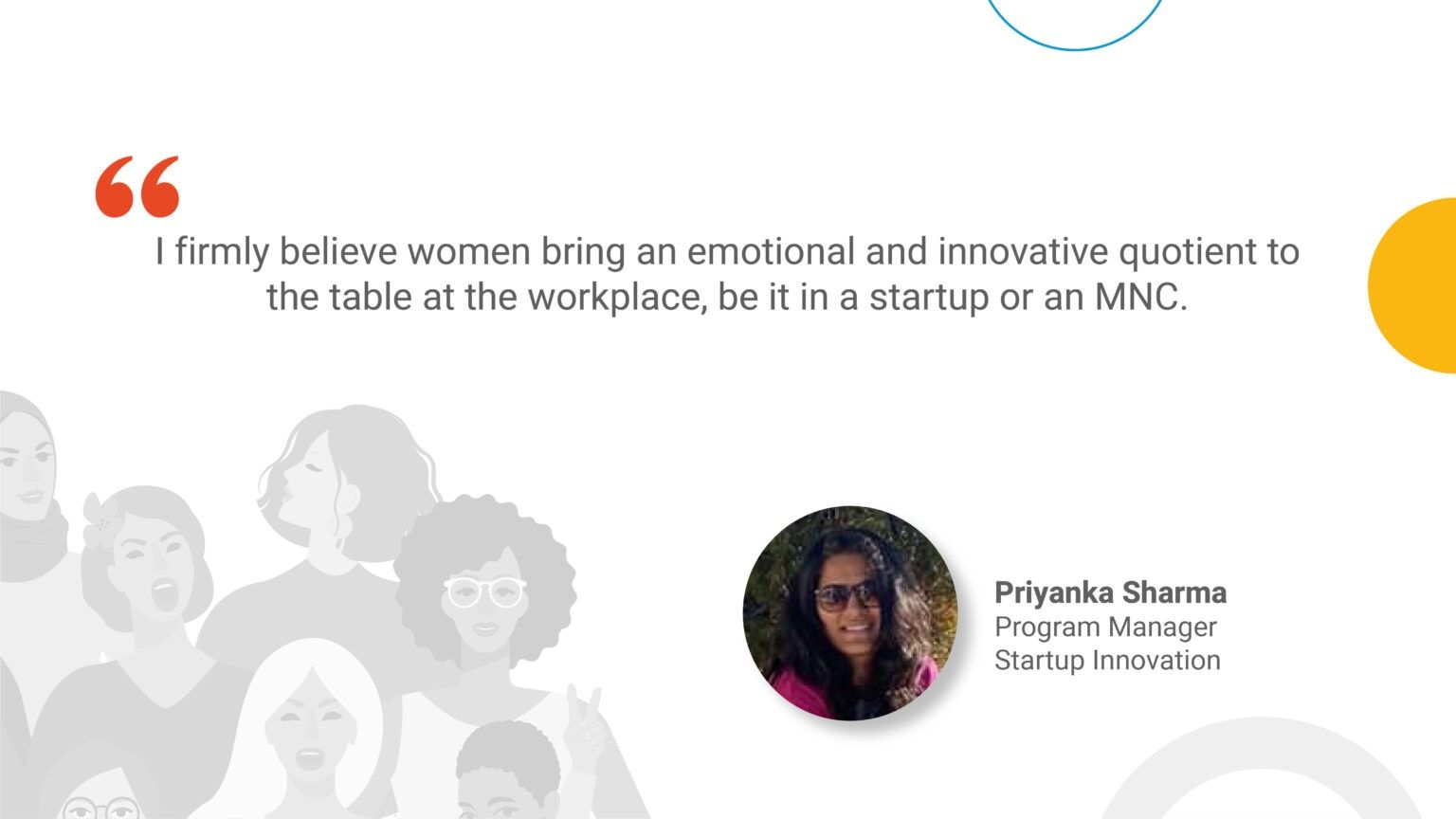
What aspect of your role do you enjoy the most?
Getting to deep dive into the problems startups face and being able to provide a hand holding support to them brings joy to my face.
How do innovation enablers like T-Hub ensure more participation from women in the startup space?
I firmly believe women bring an emotional and innovative quotient to the table at the workplace, be it in a startup or an MNC. A different view and perspective is always needed to scrutinize a query from all angles. Women do it best when it comes to handling customer relations. I look forward to T-Hub providing more opportunities enabling women leaders.
Shalini Vaddy
Q. Being a senior member in the CI team, what has been your role in shaping corporate innovation at T-Hub? What aspect of your role do you enjoy the most?
The Corporate Innovation team and T-Hub in general has been very welcoming and open regarding change. We don’t just advise our stakeholders to escort change, we embody it in everything we do. The philosophy of T-Hub revolves around creating impact. Similarly, the main deliverable of the corporate innovation team is to create a positive impact for our corporate stakeholders but this, combined with the relationship development aspect, is what deepens the impact and makes it long-lasting.

The fundamental part of my role is to reach out to corporates and engage them in conversation in order to understand their innovation needs. Following which I design corporate innovation programs that emulate their requirements. I act as a consultant for corporate innovation teams and ensure that they get access to exceptional startups that impeccably complement their organisations. An essential part of my role is to stay in touch with corporates and foster a notable relationship that ensures their active involvement in the ecosystem, which in turn benefits all the stakeholders. Also, I ensure that all our corporate stakeholders are provided with good networking opportunities. My role within the organisation involves bridging the program managers with corporate clients and the trust and reliance that we have developed as a team is remarkable.
Q. There is a dearth of women leaders in the world of corporate innovation. What steps should be taken to ensure gender equality?
The lack of women leaders in the world of corporate innovation is just one branch of gender inequality present in the entire world. I believe this stems from the acute history of women not being taken seriously in the workplace. This attitude has emerged as a standard across industries, especially, in the ecosystem of technology and entrepreneurship. One of the few steps we can take in amending this standard is to pay more attention to what women employees have to say, give them a stand to implement their novel plans and ideas. Another step that organisations can take is to start including more women in the top leadership positions. It is important to judge a candidate for a leadership position based solely on their skills and abilities rather than their perceived priorities and personal situations which is why most women are disregarded. Providing women employees with access to better opportunities and critical tasks from early on in their careers would not just give them a better playing field but will also develop their abilities and confidence from the formative years. Lastly, highlighting female role models and connecting women employees to compassionate mentors would ensure proper guidance and increase their self-confidence. For years, women have been pushed in the background and made silent, but their valour still remains.
Shanti Darisetty
Q. What has been your role in shaping corporate innovation at T-Hub? What aspect of your role do you enjoy the most?
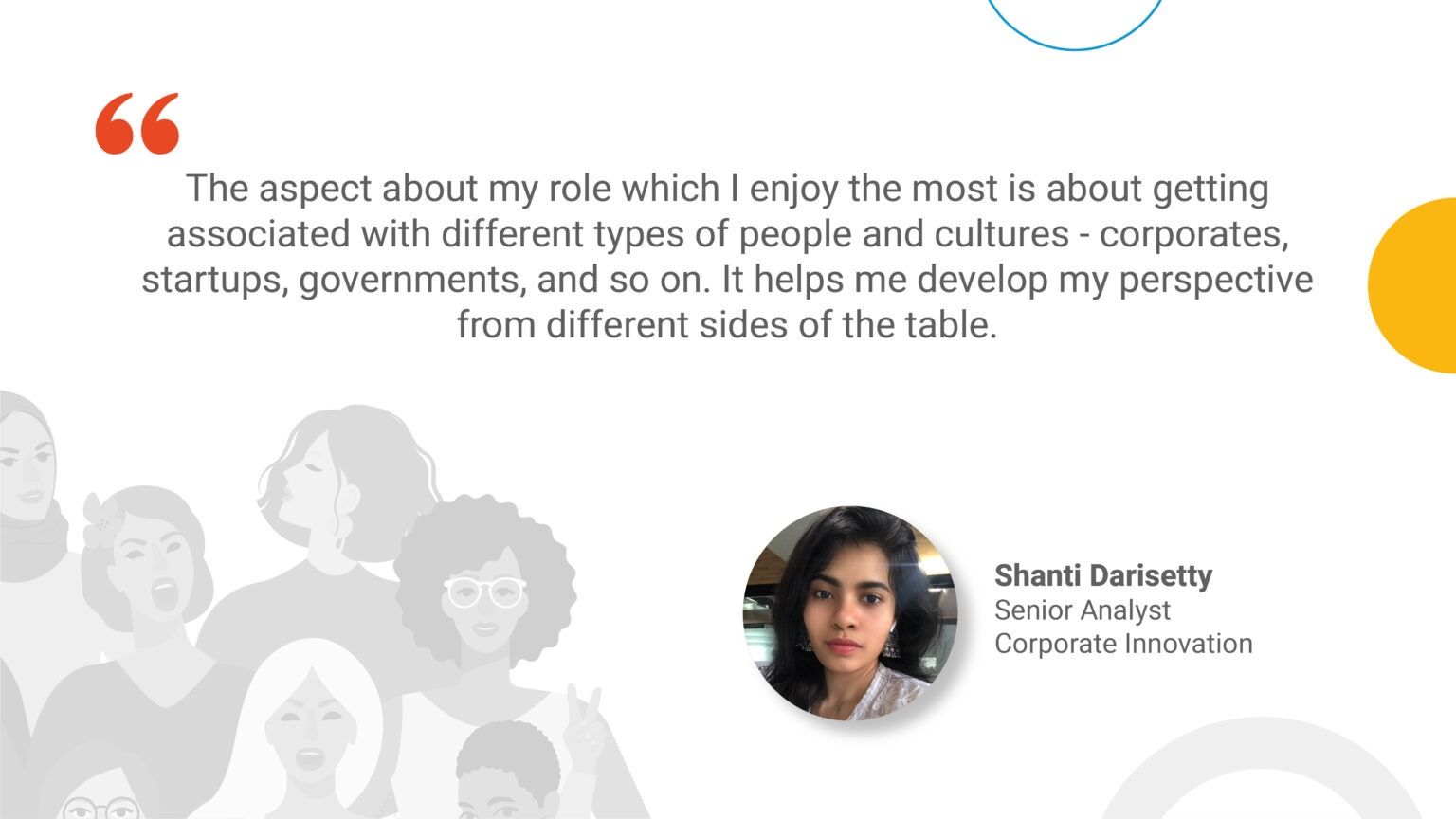
I have deployed a very diverse set of roles for shaping up Corporate Innovation at T-Hub, right from being involved in the end-to-end business development process to program management to organizing events and panel discussions. The journey and learning has been truly remarkable and I’m extremely grateful for getting a chance to get my hands dirty on such diverse roles here. The aspect about my role which I enjoy the most is about getting associated with different types of people and cultures – corporates, startups, governments, and so on. It helps me develop my perspective from different sides of the table.
Vinutha Rallapalli
Q. In your experience of having worked in the Indian startup scene, please comment on the gender disparity in VC funding in the Indian context. Will the future see a more empowered generation of Indian women entrepreneurs who may not face as many challenges to securing funding?
The three main reasons that contribute to a low world-over percentage share of women founders attracting funding are:
-Most investors fund within their own network: Given that there are nearly no active women funds to promote investments and few women in the VC world, it does end up being a male-dominated network.
– Pitch bias: Subconscious bias for male founders is real as research studies reveal. In fact, the questions asked to male and female founders are different too!
– Lack of confidence: – Women generally tend to undervalue themselves and men tend to exude higher levels of confidence with similar profiles and accomplishments.

For years efforts have been underway to bridge the gender gap but we are still <5 percent of overall VC funding. With the emergence of more VCs, focus on women founders, and more women in the VC industry, the focus is shifting from just the pitch (to avoid bias) to the technical strengths of the individual projects. Optimistically speaking, we can see a future with higher funding pumped into women-led startups.



